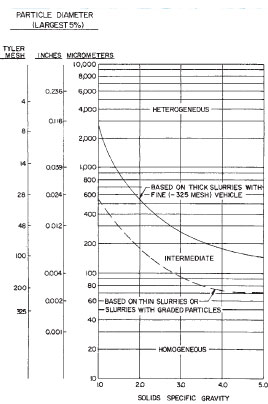Centrifugal pumps: do they handle slurries, and what is their maximum allowable working pressure?
Q. How do rotodynamic (centrifugal) pumps perform when handling slurries?
A. The performance of a rotodynamic pump on slurries will differ from its performance on water, which is the basis for most published curves. Head (H) and rate of flow (Q) will normally decrease as solids size and concentration increase. Power (P) will increase and starting torque will be higher.
In most circumstances, the net positive suction head required (NPSHR) by the pump not to exceed 3 percent head drop will increase. The effects of solids on NPSHR are dependent on the slurry type and the pump design and can be variable. For settling slurries of low to medium concentration, a modest increase in NPSHR can be expected. For a particular application, a conservative estimate of this increase can be found by dividing the value of NPSHR on water by the head de-rating factor.
For viscous and non-settling slurries or slurries with entrained air, the effect on NPSHR can be greater. The pump manufacturer should be consulted for guidance regarding slurry effects on NPSHR.
Different approaches can be used for predicting the centrifugal pump performance change from water to slurry, depending on the slurry type. When the solids-fluid mixture, as shown in Figure 12.17, is considered homogeneous and exhibits Newtonian behavior that can be characterized by an apparent viscosity, the ANSI/HI method for pump performance viscosity correction can be applied. See ANSI/HI 9.6.7 Effects of Liquid Viscosity on Rotodynamic Pump Performance.

The viscosity correction methods in HI 9.6.7 are empirical methods based on the best test data available from sources throughout the world. Many factors for particular pump geometry and flow conditions are not taken into account. However, the methods provide for dependable approximations when limited data on the application is available.
Pump users should consult with pump manufacturers for more accurate predictions of performance for a particular pump and particular slurry.
Q. What factors determine the maximum allowable working pressure of a centrifugal pump?
A. The maximum allowable working pressure (MAWP) for centrifugal pumps is based on the minimum of any or all of the following:
- The maximum allowable stress level in the pump casing. The stress level is determined by the design methods established by the American Society of Mechanical Engineers (ASME) and considers the casing material, operating temperature and factor of safety.
- Finite element stress analysis methods are often used to calculate stress levels, but empirical methods are also used based on existing designs and experience.
- Allowance for casing wall corrosion and manufacturing thickness is also added to the desired wall thickness. In this regard, manufacturers often provide minimum casing wall thickness for use in monitoring the service life of a pump casing.
- Pressure ratings for standard design flanges used to connect pumps to the system are a major consideration, and many pump MAWP ratings are equal to the flange ratings. The minimum casing wall thickness is then calculated to match the flange rating.
- Mechanical seal housing design and seal selection must also be capable of withstanding the MAWP.

